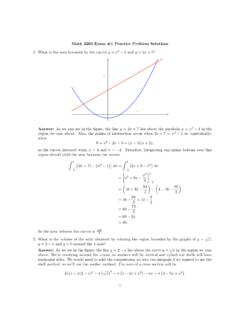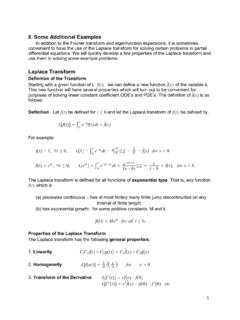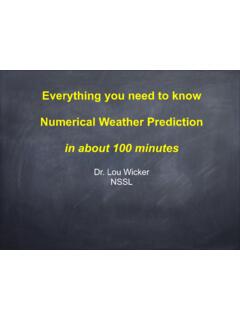Transcription of MATHEMATICAL MODELING A Comprehensive Introduction
1 MATHEMATICAL MODELINGA Comprehensive IntroductionGerhard Dangelmayr and Michael KirbyDepartment of MathematicsColorado State UniversityFort Collins, Colorado, 80523 PRENTICE HALL,Upper Saddle River, New Jersey 07458 ContentsPreface51 MATHEMATICAL Examples of MODELING .. MODELING with Difference Equations .. MODELING with Ordinary Differential Equations .. MODELING with Partial Differential Equation .. Optimization .. MODELING with Simulations .. Function Fitting: Data MODELING .. The MODELING Process .. An Algorithm for MODELING ? .. The Delicate Science of Errors .. Purpose of this Course.
2 112 Qualitative MODELING with MODELING Species Propagation .. Supply and Demand .. Market Equilibrium .. Market Adjustment .. Taxation .. MODELING with Proportion and Scale .. Proportion .. Scale .. Dimensional Analysis .. Dimensional homogeneity .. Discovering Joint Proportions .. Procedure for Nondimensionalization .. MODELING with Dimensional Analysis .. 32 Bibliography383 Linear Examples of Linear Programs .. Red or White? .. How Many Fish? .. Geometric Solution of a 2D Linear Program .. Sensitivity Analysis .. Price Sensitivity.
3 Resource Sensitivity .. Constraint Coefficient Sensitivity .. Linear Programs with Equality Constraints .. A Task Scheduling Problem .. Transportation Problems .. A Targeting Problem .. Discretization and Solution of the Equations of Motion .. Formulation as Linear Program .. Targeting Problem with Air Resistance .. Additional Constraints .. Analysis of the Targeting Problem .. Analytical Solution .. Dimensionless Variables .. Maximum Altitude .. 594 MODELING with Nonlinear Unconstrained Optimization in One Dimension .. Bisection Algorithm .. Newton s Method.
4 Unconstrained Optimization in Higher Dimensions .. Taylor Series in Higher Dimensions .. Roots of a Nonlinear system .. Newton s Method .. Steepest Descent .. Constrained Optimization and Lagrange Multipliers .. Geometry of Constrained Optimization .. One Equality Constraint .. Several Equality Constraints .. Inequality Constraints .. MODELING Examples .. 795 Empirical MODELING with Data Linear Least Squares .. The Mammalian Heart Revisited .. General Formulation .. Exponential Fits .. Fitting Data with Polynomials .. Interpolation versus Least Squares.
5 Splines .. Linear Splines .. Cubic Splines .. Data Fitting and the Uniform Approximation .. Error Model Selection? .. 1026 MODELING with discrete dynamical Introduction .. Linear First Order Difference Equations .. Analytical Solutions .. MODELING Examples .. Linear Second Order Equations .. Homogeneous Equations .. The Cobweb Model Revisited .. Nonlinear Difference Equations and Systems in Population MODELING Systems of Equations and Competing Species .. Empirical MODELING .. Non-Newtonian Fish? .. Predator or Prey? .. 1317 Simulation The Tire Distributor Problem.
6 Blackjack Strategy .. 142 APPENDICESA Matlab Code for Data Mammalian Heart Rate Problem .. Least Squares with Normal Equations .. Least Squares with Overdetermined system .. Non-Newtonian Fish .. Preditor or Prey? .. Tire Distributor .. Blackjack .. 158 PrefaceThese materials are being developed with support from National Science Founda-tion Award no. 0126650 entitledA MATHEMATICAL MODELING Program for Undergrad-uates in Science, Mathematics, Engineering and objective of this project is the development of innovative educationalmaterials that incorporate a novel educational approach and perspective to enhancethe teaching and learning of mathematics for the purposes of knowledge general undergraduate educated with these materials will possess a readilyapplicable toolbox of MATHEMATICAL ideas for quantifying real world problems aswell as problem solving skills, and possibly the most importantly.
7 Theability tointerpret results and further pedagogical perspective consists of the observation that mathematicalmodeling is often taught backwards. An application of interest is presented andthen appropriate MATHEMATICAL tools are subsequently invoked. The beginner isleft with the obvious concern. How does one decide which method to use on a newproblem? Our proposed solution to this dilemma is to teach mathematics first andthen show why a given MATHEMATICAL methodology can be applied to the modelingproblem. We will be successful if the student completes their MODELING course basedon these materials with a good sense of what makes various MATHEMATICAL methodsinherently different.
8 Furthermore, students that are aware of the fundamental dis-tinguishing characteristics of the array of methodologies should now be equipped toaddress this question of central importance in MODELING , , which method when!This text is the first of two planned works to establish proof of concept ofa new approach to teaching MATHEMATICAL MODELING . The scope of the text is thebasic theory of MODELING from a MATHEMATICAL perspective. A second applicationsfocussed text will build on the basic material of the first is typical that students in a MATHEMATICAL MODELING class come from a widevariety of disciplines. In addition, their preparation and MATHEMATICAL sophistica-tion can vary as widely as their areas of interest.
9 This heterogeneity makes theteaching and learning of MATHEMATICAL MODELING a significant challenge. One of themain student prototypes is a intelligent although possibly mathematically naivestudent that must learn mathematically MODELING to make progress in an area ofresearch. If a course or textbook does not provide the necessary information forthese good students to bridge educational gaps students everyone suffers. Indeed,most textbooks fail to be accessible to such enhancing accessibility as our motivation, we propose to implement asimple pedagogical device to facilitate the use of the text by students of widelyvarying backgrounds.
10 This device consists of graded levels of presentation denotedby (E) for elementary, (I) for intermediate and (A) for advanced. (E) MATHEMATICAL beginners will find much of interest in the elementary sec-tions as well as foundation material for further study. The diligent studentcan use this self-contained treatment to pave the way to reading of moreadvanced sections. The basic properties of MATHEMATICAL techniques will bepresented with an emphasis on how methods lead to specific (I) Intermediate material builds on the elementary material and extends thestudents expertise. Often intermediate material will involve computer exper-iments to stimulate more theoretical discussions in the advanced good understanding of intermediate material should permit a student todevelop new applications of central MATHEMATICAL ideas.











